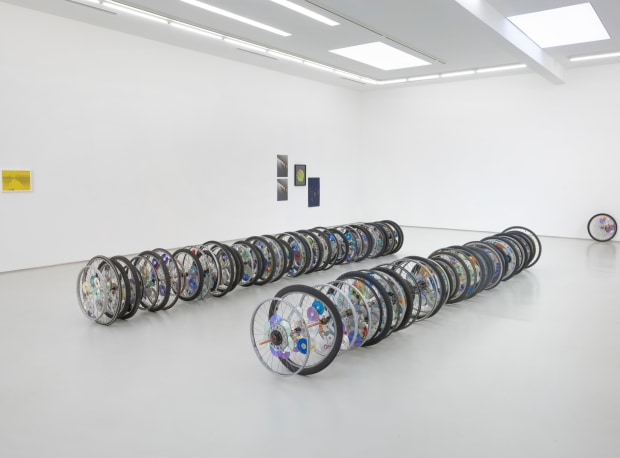
By Carolina A. Miranda
If you’d walked into Kori Newkirk’s sunny studio in downtown Los Angeles late last month, you would have found a wonderland of scavenged bits. Racks of cassette tapes. A tower of brightly colored pool floats. Several dozen bicycle wheels in various states of disassembly. Not to mention a mannequin head dipped in glitter, a pug doll with a jeweled collar and, pinned to one wall, a round of pita bread — evidence of the artist’s ongoing obsession with circles.
“If this were the East Coast, that thing would have sprouted all kinds of mold,” Newkirk said, chuckling. “But this is California. It just dried right out.”
Newkirk was in the midst of preparing for his first Los Angeles exhibition in five years — a one-man show that opened Saturday at Roberts & Tilton in Culver City, where he is showing a series of new sculptural works crafted from the explosion of bicycle wheels carpeting his studio floor. (He was circumspect on what exactly he was making with them: “I don’t like to give too much away before an opening,” he explained.)
Interview by Christine Y. Kim
Known for his ever-evolving approach to painting, sculptural installation and photography, Bronx-born artist Kori Newkirk uninhibitedly explores cultural identity, black history and individual experience. His study of human landscapes and commerce has translated to a vast array of media—from artificial hair, pony beads and pomade to fiberglass and space-age materials. For his show opening at Los Angeles’ Roberts & Tilton Gallery, Newkirk turns his attention to the circle, examining its singular place in angular geometry, its human function as the wheel and the symbolic narratives that exist in both.
LACMA Associate Curator Christine Y. Kim first worked with Newkirk in 2001 in her former post at the Studio Museum in Harlem. The two discuss Newkirk’s evolving practice and his constant dedication to idea over form.
